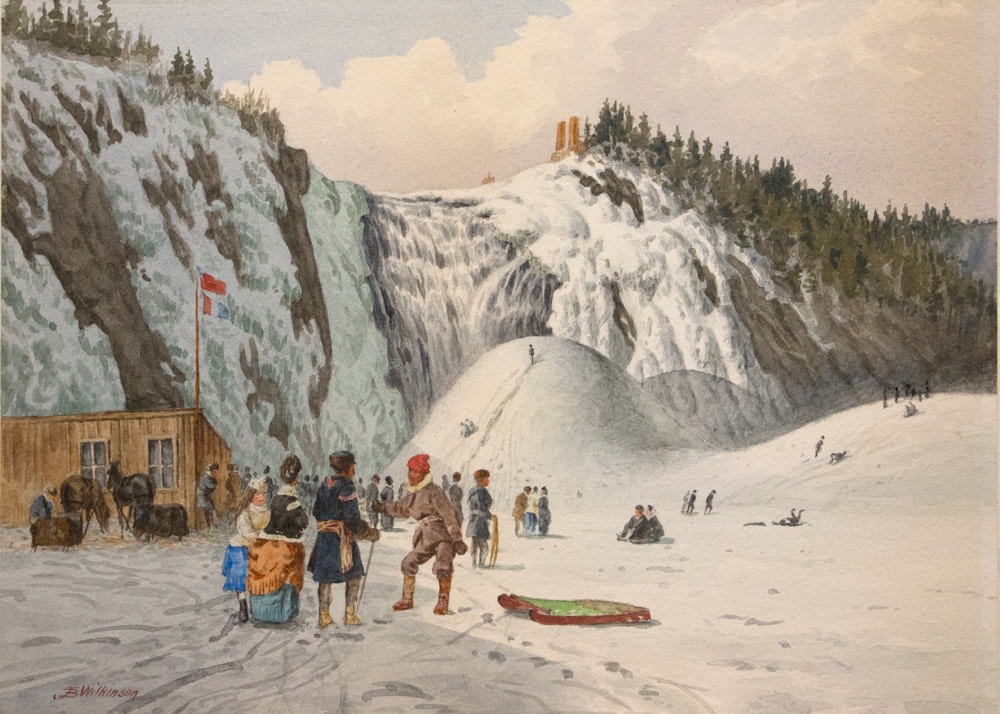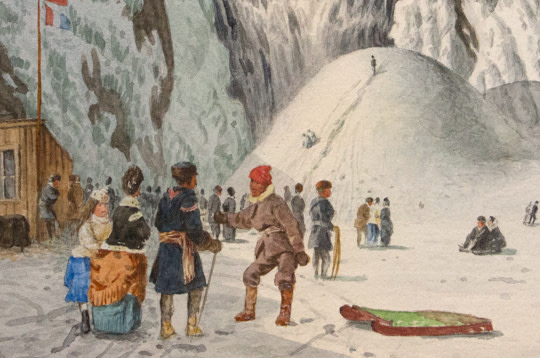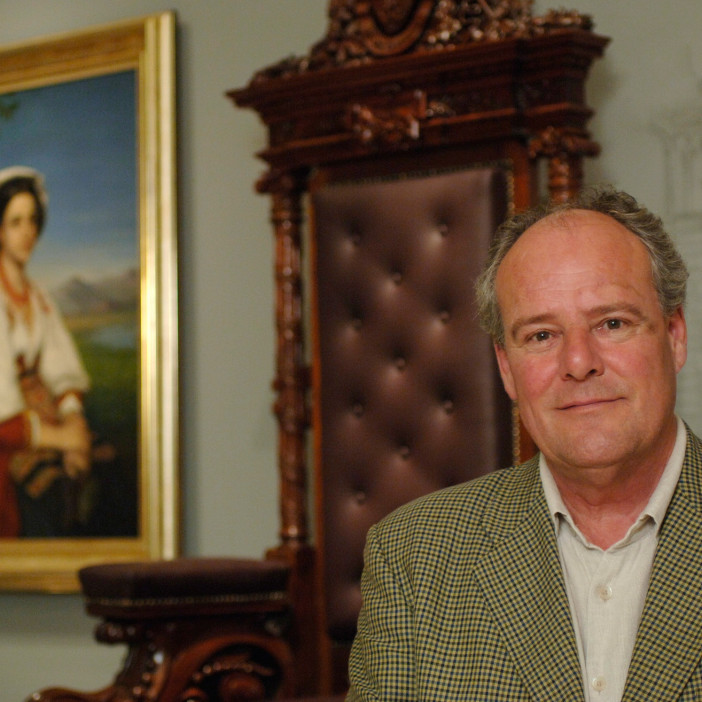Travel and Tourism in Wilkinson's 19th Century Watercolour

John B. Wilkinson , Ice Cone at Montmorency Falls, c. 1870
watercolour, 8 1/2 x 11 3/4 in.
Montmorency Falls has long been a popular year-round destination for Quebecers and tourists alike, each searching for an inspiring spot for contemplation, activities and revelry. In winter, the spray and mist at the foot of the waterfall create a 30-foot high mountain of ice and snow over the rapids, commonly referred to as the “Ice Cone.” This spectacular natural phenomenon just outside Québec City quickly became a major attraction. The area became a destination for climbing, snowshoeing, sledding and tobogganing, sleigh rides, sledding races, ice sculpture and even dancing and picnics! From the end of the 18th Century to around the 1870s, this “exotic” and festive site captured the interest of many British officers proficient in watercolour as well as professional painters and photographers.
Wilkinson’s watercolour composition of the Ice Cone from the western base is positioned near a seasonal wooden shack used as a tavern and topped with a mast, bearing the Union Jack flying above the French flag. Flanking this temporary refreshment stall are two horses, each hitched to fur-covered sedans or sleighs.

Detail of Ice Cone at Montmorency Falls.
The artist draws our attention to a group of four people in the foreground: on the left, a couple seen from behind, accompanied by their daughter who is listening intently to an habitant on the right, who is pointing to a sled on the ground. This Canadien seems to be in the midst of a negotiation, possibly attempting to convince the visitors to rent his sled and services to pull them up the Ice Cone. This hypothesis seems plausible, particularly since the woman and the girl are in no way dressed for climbing the hill and a lone figure at the peak of the Cone is depicted watching another couple slide down. In any case, this anecdotal scene demonstrates Wilkinson’s great talent for watercolour, particularly evident in his play of light and shadow of the cliffs, as well as in the contrasting textures of the fir trees, the ice and the rocks on either side of the falls. Rendered in all its splendour, this is an important artistic and ethnographic view of what became a true icon of Canadian imagery in the 19th Century.
Not much is known about John B. Wilkinson. Originally from England, Wilkinson lived in Québec in December 1864 where he worked as a tinter at À l’enseigne du Soleil d’Or (Sign of the Golden Sun), a photographic studio owned by Jules-Isaïe Benoît dit Livernois. Wilkinson and his colleague, Joseph Dynes, tinted photographs, particularly life-sized portraits, with oil and watercolour. The two artists worked there together until June 1865 when Wilkinson, clearly a talented and conscientious portraitist, set up his own studio at 28, rue Saint-Jean, where he painted portraits on canvas from life or painted copies of miniatures to custom size specifications.
In October of that year, the artist offered a painting and drawing class with models in his studio, capitalizing on his “extensive teaching experience in England.” In 1870, Wilkinson presented a Vermont landscape at the exhibition of the Society of Canadian Artists held at the Art Association of Montreal and the following year, he exhibited a collection of his paintings at Morgan’s, a music store in Québec City. In January 1873, Canadian Illustrated News published two Wilkinson drawings of the Governor General, Lord Dufferin, on a sleigh-outing at Montmorency. In March, however, his lack of commissions forced him to close his studio and to pursue his career in Philadelphia.
Despite the distance, Wilkinson did however maintain ties to Québec: in 1879, Canadian Illustrated News and L’Opinion publique engrave one of his paintings (Falls on the Jaune River, near Quebec / Chutes sur la Rivière-Jaune, près de Québec) and eight Québec landscapes are featured at Montreal’s Hicks auction house in 1888. If Wilkinson’s landscapes of Charlevoix, the Eastern Townships and Québec City area are rare, his more numerous winter scenes in watercolour boast signature characteristics: the caribou hunt, ice fishing, tobogganing, ice-crossing at Québec, sledding, sledding accidents, being lost in a snowstorm, logging, etc. His Ice Cone at Montmorency Falls belongs to this important repertoire of local iconography.
Mario Béland, PHD, FRSC.
Mario Béland was the curator of the Musée national des beaux-arts du Québec from 1985 to 2014. He collaborated, coordinated and organized more than 40 monograph or thematic exhibitions, both temporary and permanent. He also authored or supervised a dozen works on Québec historic art as well as publishing scores of articles, essays, and brochures in journals, magazines, collective works, and exhibition catalogues. Fellow of the Royal Society of Canada since 2009, Mario Béland was awarded the Prix Carrière de la Société des musées du Québec (lifetime achievement award from the Québec Society of Museums) in 2014.





Comments
Being a traveling freak always like o read kind of blog. I must say that this one helps me a lot to make my one day trip from philadelphia as I really want to enjoy soon. Thanks for sharing this.
Add a comment